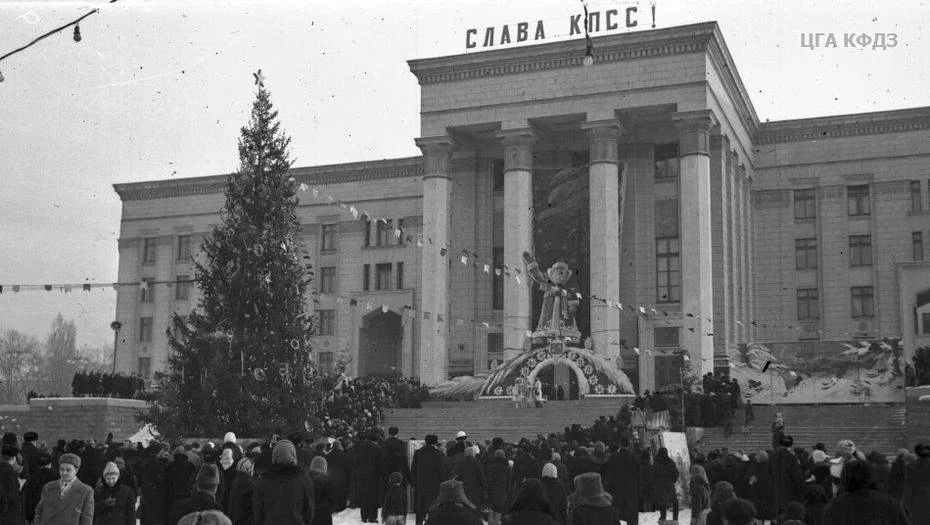During the Soviet era, having and maintaining traditions played a key role in shaping the socialist way of life and reinforcing collectivist ideals. Among these, the celebration of New Year had special significance, emerging as a symbol of status and modernity, while simultaneously reflecting pan-Soviet values and the aspiration for unity. Today, let us explore newspaper advertisements from the post-Second World War years and shed light on how new rituals and celebrations combined the promotion of collectivism with displays of elitism in Soviet Kazakhstan.
With the establishment of Soviet power, debates began over whether the tradition of setting up a tree as part of New Year’s celebrations should be preserved. In the early years of the Soviet Union, opinions were divided. Some proposed keeping the tree while stripping it of its Christmas associations, while others strongly opposed the idea, arguing that the tree had deep ties to the church and bourgeois culture and should not be supported. Other critics viewed the tree as a symbol of the bourgeois commercialization of Christmas.
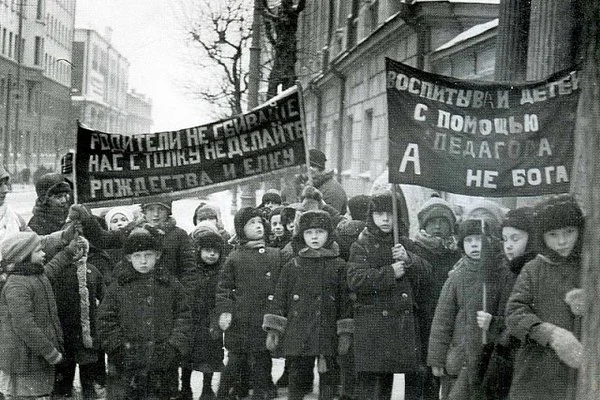
Demonstration against Christmas and the tree in 1929/Wikimedia commons
By the late 1920s, however, the Christmas tree was declared a ‘bourgeois prejudice’ and rejected not only for ideological but also for practical reasons. Anti-Christmas-tree propaganda claimed that the widespread destruction of young trees caused significant economic damage. Thus, in 1928, the tree was officially banned, and Ded Moroz, the Russian version of Father Frost, was labeled an ally of priests and kulaks.
The Return of the New Year Tree
In the mid-1930s, attitudes toward New Year and the tree underwent a radical transformation. The idea of using New Year and the Christmas tree to promote state interests was openly discussed. A campaign to revive the tradition was launched, framed as being viewed from the perspective of bringing Soviet children joy during the holidays, especially given the lack of a proper and cheerful alternative celebration for their upbringing. It was emphasized that the tree should not be regarded as a religious superstition since it was not a Christian custom but rather a tradition rooted in paganism.
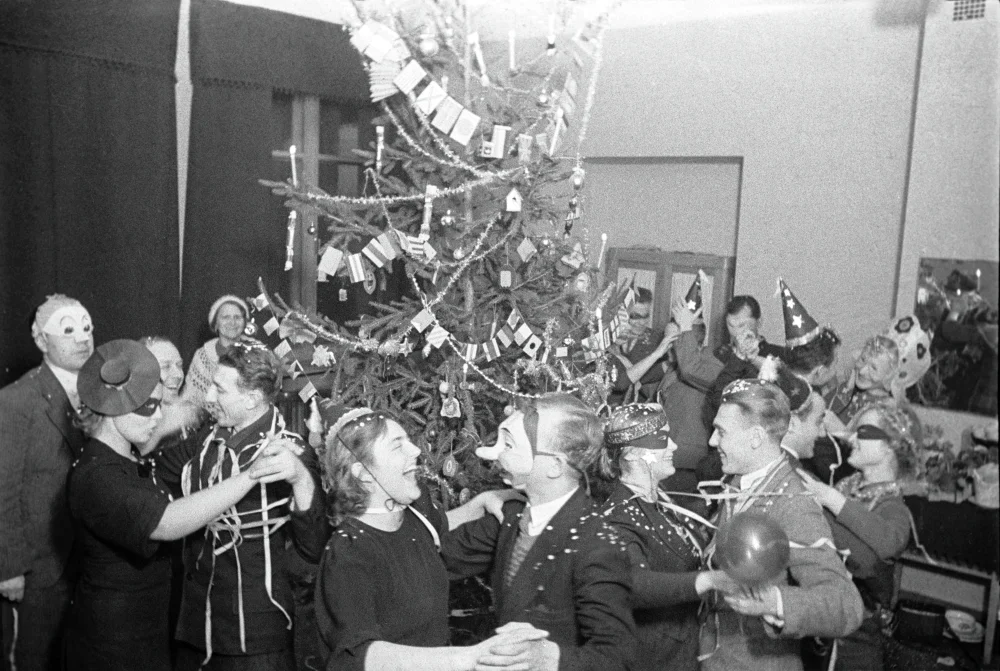
New Year's Eve in one of Moscow's clubs. 1938/RIA
From 1935 onward, the Christmas tree regained its place in Soviet celebrations, undergoing an ideological rebranding: from being labeled an ‘enemy of the people’ to becoming a symbol of joy, family comfort, and unity, adapted to the goals of the socialist state.
New Year: A Propaganda Tool
The revival of the tradition of New Year and increasing popularity of the tree in the 1930s became a pragmatic step to strengthen festive traditions, fill a void in the Soviet calendar, and mobilize the population. Children were given special attention, which also encouraged women to participate in official Soviet events. However, not all public celebrations strictly adhered to the prescriptions of official ideology. Traditional customs, including elements of Christmas, found their way into New Year festivities.
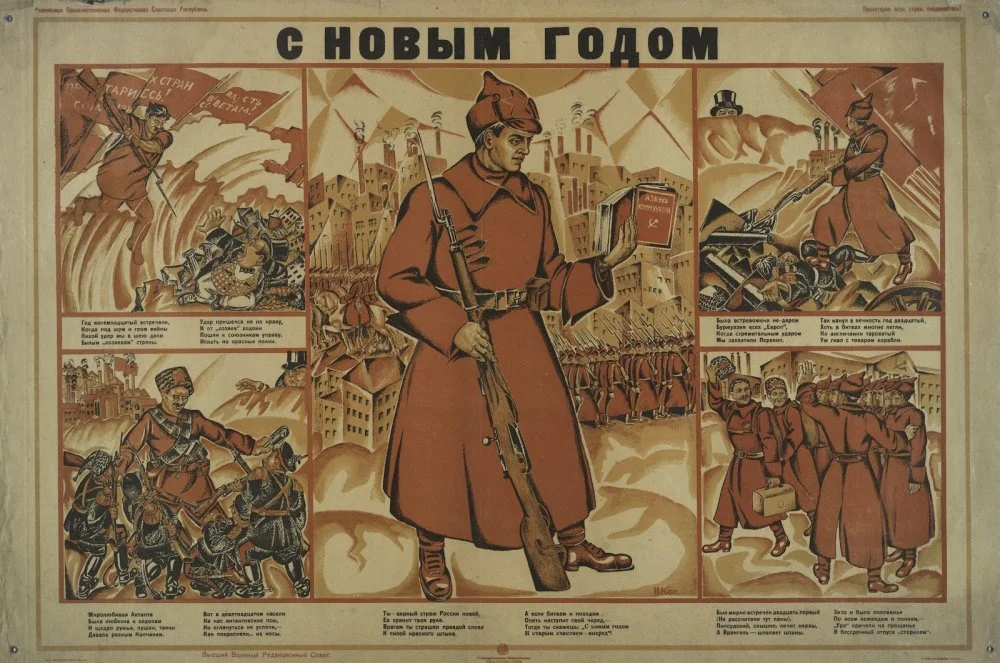
Happy New Year! 1918/Photo by Heritage Art/Heritage Images via Getty Images
New Year celebrations also developed a broad spectrum of societal meanings, reinforcing social hierarchies. Lavish trees, exquisite dishes, and grand events were organized for the party elite. The Soviet media portrayed scenes of abundance—tables laden with delicacies, brightly decorated trees, and an atmosphere of festive joy. Meanwhile, those with sufficient material means set up trees at home, decorated them, and prepared special meals, occasionally covertly linking these celebrations to Christmas, despite official bans. This reflected the duality of cultural adaptation: publicly, the New Year emphasized Soviet values, but in private life, it could retain elements of traditional practices.
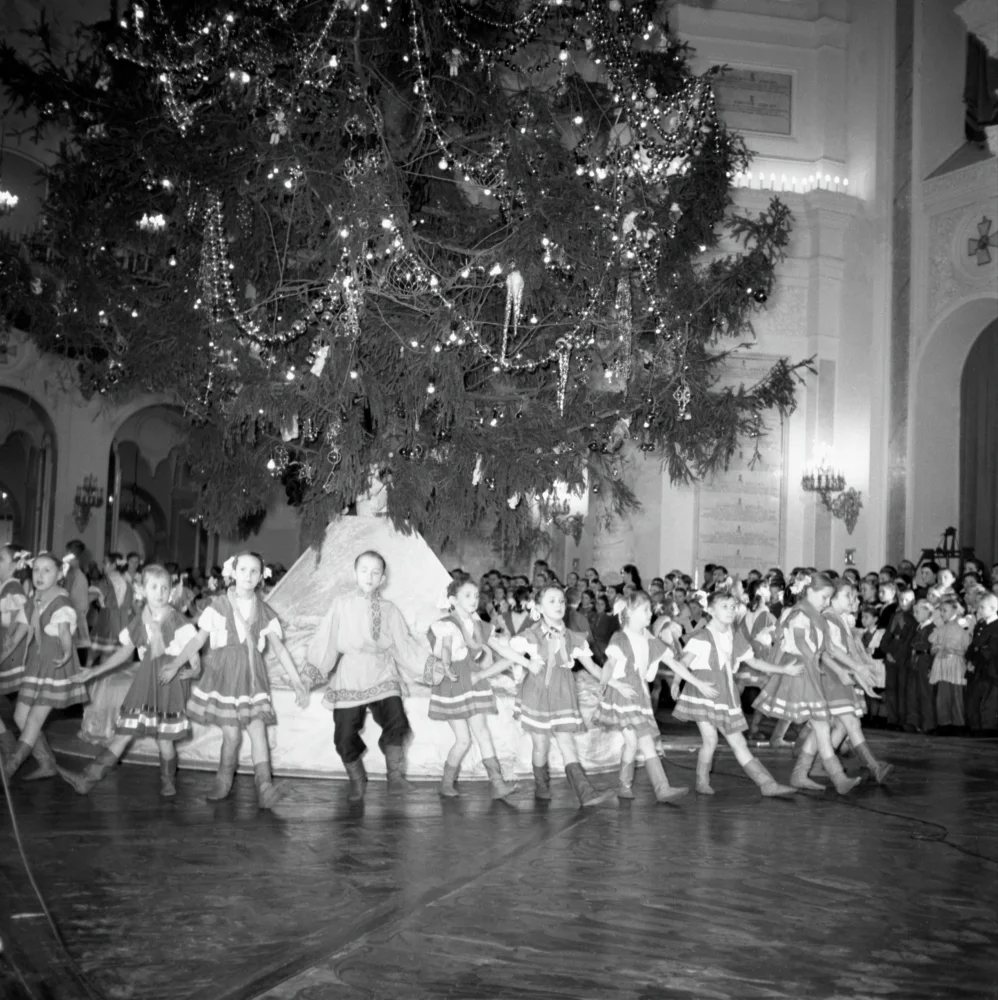
Children's New Year's party in the Kremlin/David Sholomovich/RIA Novosti
The Establishment of New Year Celebrations in the Kazakh SSR
In societies with Christian traditions, the Soviet New Year borrowed elements of Christmas, making it easier for the population to embrace. However, in cultures like the Kazakh one, this holiday had neither historical nor religious roots.
For the Kazakhs, historically nomads with a Muslim worldview, the New Year was as foreign as other Soviet holidays. It was introduced alongside ideological subjugation, transforming it into a distinctly Soviet celebration. Consequently, all the rituals associated with New Year’s festivities should be viewed within the context of the Sovietization of the Kazakhs and the effort to establish the spiritual foundations of a socialist way of life.
Unlike many Soviet holidays that lost their relevance after the collapse of the USSR, the New Year retained its popularity, becoming part of everyday life and cultural heritage, reinterpreted within the realities of the modern era.
The Capital and the Regions
From the 1940s to the 1950s, New Year in the Kazakh Soviet Socialist Republic (Kazakh SSR) was officially presented as a grand, well-organized holiday. Newspapers consistently highlighted examples from Almaty, which served as a focal point and a showcase for the successes of socialism.
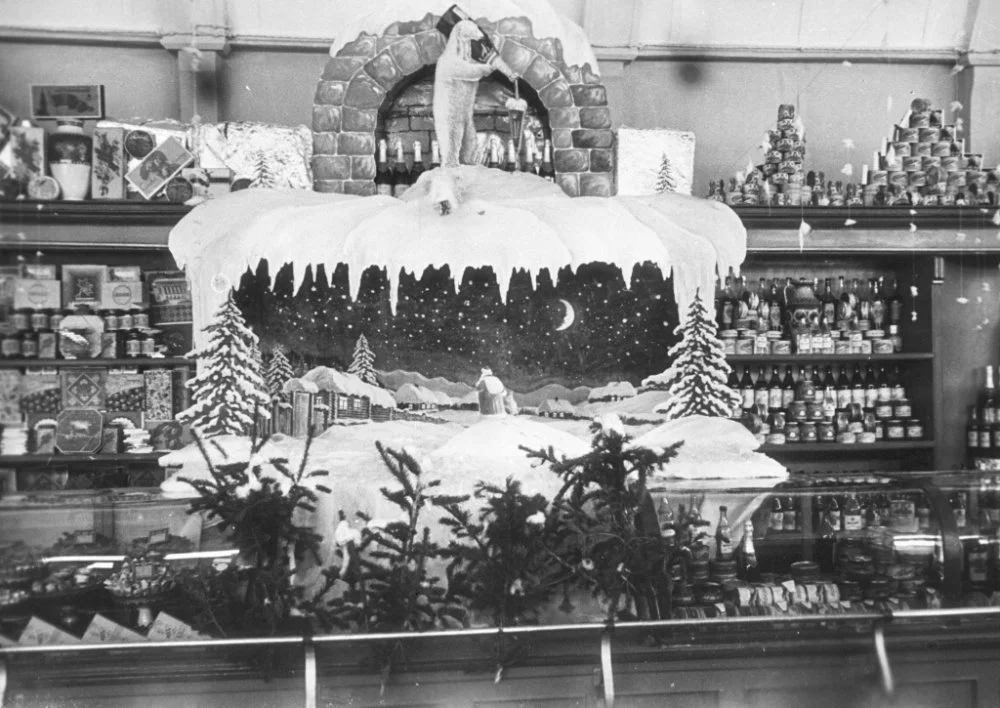
Alma-Ata, 1951. Gastronomic department of the store No. 4 "Gastronom" at the House of Ministries. In the photo: general view of the store's decorations for New Year's trade/From the public domain
In the capital, morning performances included puppet shows and jazz concerts in cinemas. Parks offered winter attractions such as carousels, snow slides, and donkey rides accompanied by brass bands. Restaurants and tea houses under the Almaty Dining and Restaurant Trust prepared New Year’s Eve festivities and tree-lighting events. For instance, the December 1946 issue of Kazakhstanskaya Pravda featured an invitation from the Ala-Tau restaurant, one of the largest in the republic, for an event that lasted until 6 a.m.:
A grand concert featuring the best variety performers. Jazz, dancing, confetti, and streamers. A wide selection of cold and hot appetizers. Wines, vodka, cognac, liqueurs, infusions, champagne, and various fruits.
… Celebrate New Year’s Eve in restaurants! New Year events at bars have been organized by the Almaty Dining and Restaurant Trust. (1947)
In addition to the usual dancing and spraying of confetti, games and even a masquerade ball were held for New Year’s. This is the announcement from Restaurant No. 1:
Celebrate New Year’s at Restaurant No. 1 (Stalin Avenue, corner of Dzhambul Street). Masquerade Ball. Games, dancing, confetti, streamers. Prize for the best costume! (1948)
New Year’s festivities were held not only in restaurants but also in cafes and snack bars. However, such celebrations were much more modest, without a wide range of alcoholic beverages or dancing:
New Year holiday festivities at Snack Bar No. 1 (Sovetskaya Street, corner of Panfilov Street). New Year trees have been set up in tea houses and dining halls. Orders for cold dishes to take home will be accepted. (1951)
This is another ad from 1953:
During the New Year holidays, all establishments under the Almaty Dining and Restaurant Trust expand their assortment of cold appetizers and dishes. Celebrate New Year’s Eve in our restaurants, tea houses, and dining halls! (1953)
However, behind the glitter of the capital’s festivities lay a different reality. For most residents of the republic, the postwar years were marked by systemic hunger, repression, and poverty. In the various regions, New Year, if it was celebrated at all, took the form of school morning performances and modest events in local clubs, while district centers organized fairs. Meanwhile, the best agricultural products from all suitable collective farms were sent to the republic’s capital to ensure a variety of goods at the capital's markets.
As the capital, Almaty was expected to showcase the achievements of socialism. Therefore, in the days leading up to New Year, attention was focused on the luxury of the holiday bustle.
It is customary for Soviet people to celebrate the New Year’s holiday at a richly set table. That is why all the stores in the capital of Kazakhstan are particularly crowded during these days. The shelves are stocked with the widest variety of gastronomic and grocery products. There are fourteen types of sausages alone, several varieties of cheese, a large selection of canned goods—fish, meat, vegetables—and all kinds of confectionery and wine products. (1952)
After a wave of Soviet anti-alcohol campaigns, alcoholic beverages began to play an important role in the ideological promotion of the Soviet lifestyle, especially in the Central Asian republics. At the forefront was the most Soviet of all drinks, ‘Soviet champagne’ (Sovetskoye Shampanskoye)i
For the holiday, family celebration, or gathering with friends, don’t forget to buy Soviet champagne! It perfectly combines a delicate aroma, excellent taste, and moderate strength. It retains all the valuable qualities of the finest grape varieties. (1952)
Of course, champagne alone, even Soviet champagne, wasn’t the whole story because snacks were also an essential part of the celebration:
During the New Year season, the Almaty City Food Trade Department (GorPishcheTorg) offers a wide selection in its stores, including grape, fruit, and berry wines, champagne, cognacs, liqueurs, tinctures, fish and vegetable canned goods, various sausage products, confectioneries from factories in Moscow and Almaty, bagels, pretzels, pastries, halvah, bread loaves, donuts, jams, preserves, and fruit and tomato juices.
Specialized meat and vegetable shops feature items such as poultry, beef, lamb, and a variety of pickled and marinated vegetables. (1953)
Advertisements didn’t forget to mention the New Year tree, which, according to them, was selling like hotcakes, even delivered on ‘unflappable donkeys’:
‘The square near the opera theater is buzzing with cheerful fairground chatter. For several days now, there has been a brisk sale of New Year trees. From here, the green beauties are distributed across the city. They are transported by trucks and sleds, on carts pulled by unflappable donkeys, or simply carried on shoulders if the destination is nearby. (1958)
Celebrating New Year with a private tree at home became a status symbol among the new elite, as special holiday purchases, such as decorations, were accessible only to urban citizens with resources. New Year festivities, including masquerade balls with jazz orchestras and dancing, served as a showcase of Soviet modernity. However, this did not erase the existing inequalities in access to goods and official luxury, which vividly underscored social stratification behind the façade of propaganda.
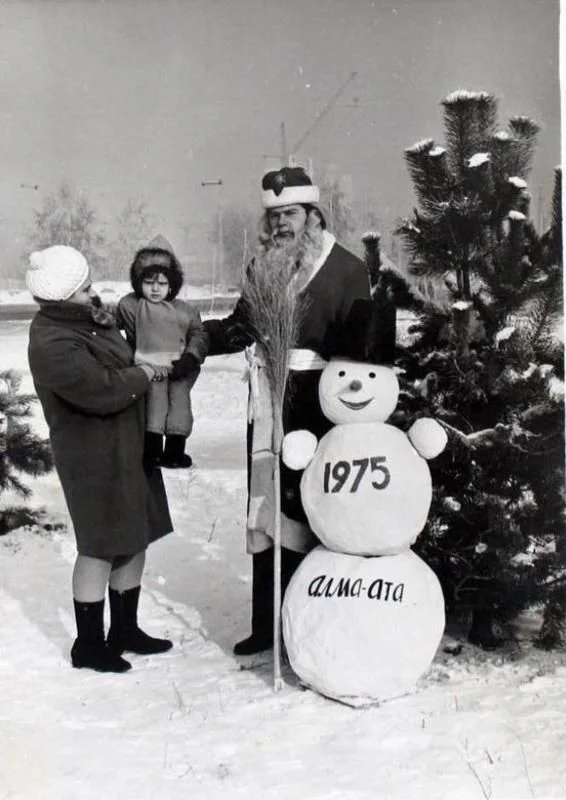
Almaty, Kazakh SSR, author: D. Bugaeva/https://russiainphoto.ru/
In reality, these celebrations remained accessible only to select segments of the population, symbolizing prestige and belonging to the ‘privileged’ class—a status many aspired to attain.
New Year—A Holiday for the Whole Country
In December 1960, newspapers wrote:
In Almaty, a wonderful tradition has been born. It is now becoming customary to hold a cheerful, music-filled celebration around the beautiful New Year tree on Soviet Street near the government building.
The introduction of the first public tree in the city center symbolized a significant change: New Year, which had previously been a privilege of the urban elite, became accessible to all segments of the population. The public tree transformed into a space where the personal and public, familial and state spheres merged.
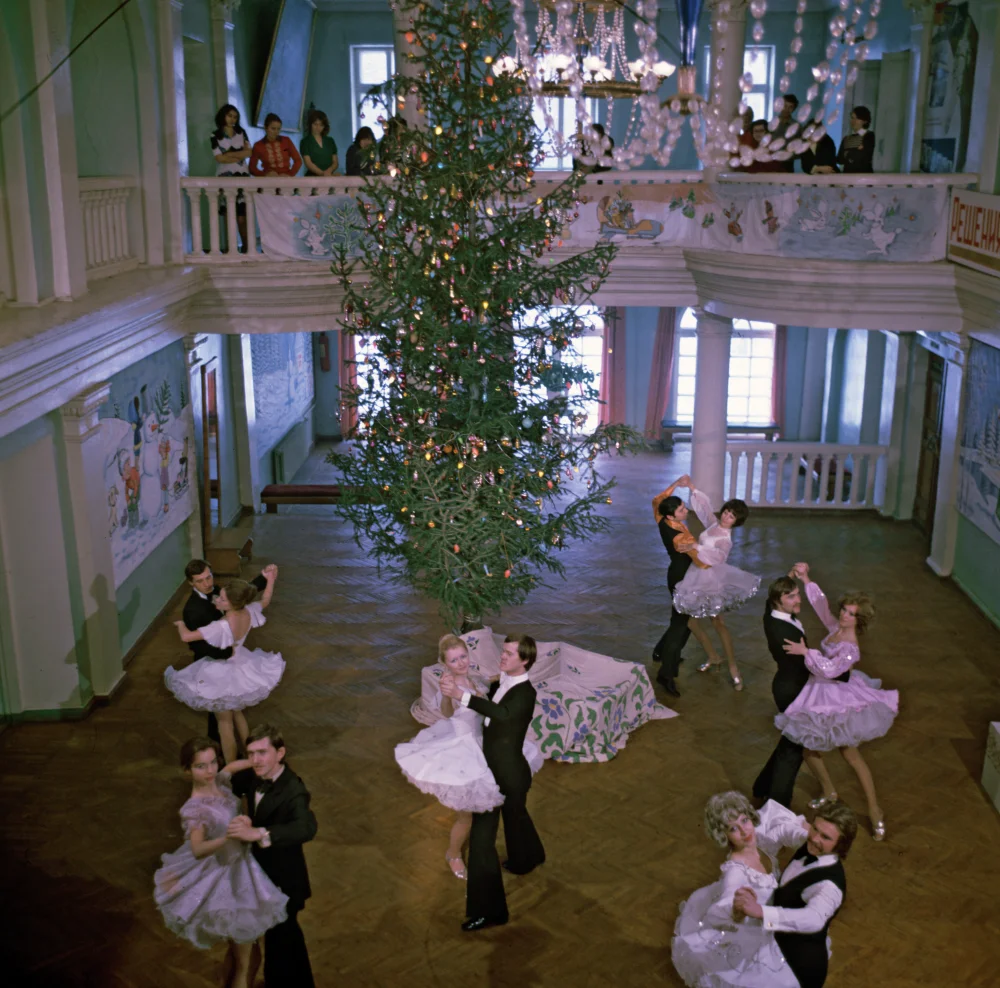
Ballroom dance ensemble at the New Year's party at the club of the Alma-Ata Cotton Mill named after the 50th Anniversary of October/Yuri Kuidin/RIA Novosti
Under the glow of colorful lights, all Almaty residents could feel like part of one large Soviet family. This idea was captured in the poetry of the time:
The clock strikes twelve
On the Kremlin tower!
Across the farthest borders,
The New Year’s table
Brings together a family,
A family of two hundred million!
Such verses, frequently published in the newspapers of the Kazakh SSR, emphasized the ideological significance of the holiday. New Year was presented not only as a time of joy but also as an important tool for fostering civic and communist values. The celebration demonstrated the state’s care for each of its citizens. Thus, the adoption of New Year in Kazakh culture became part of a broader dynamic of Sovietization.
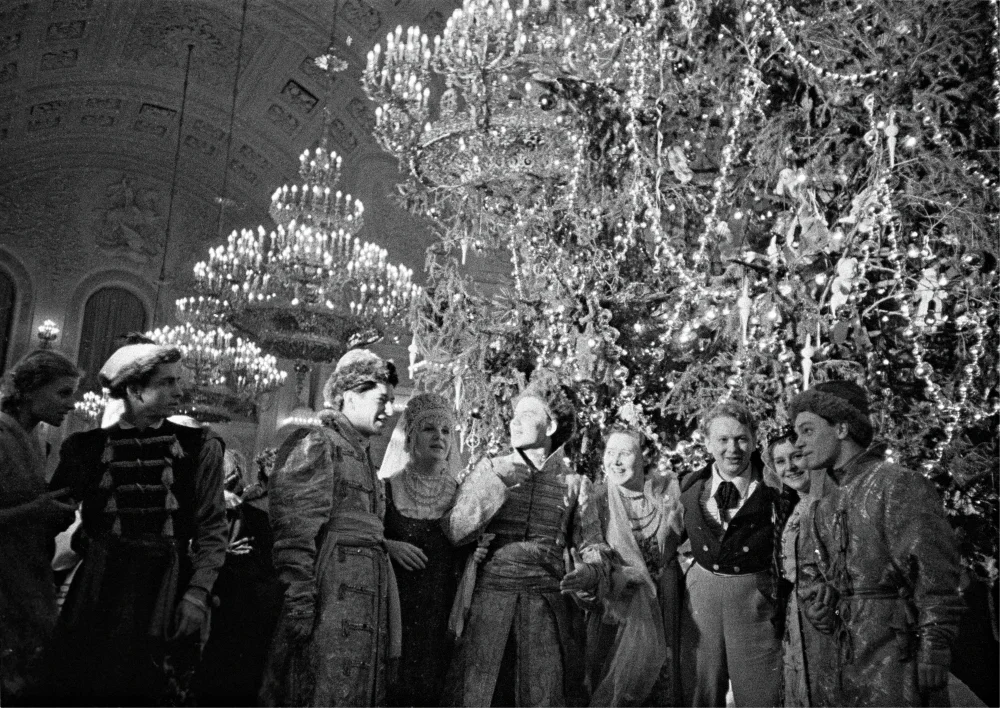
New Year's Ball for Young People in the Kremlin. Moscow, 1954/Anatoly Garanin/RIA Novosti
